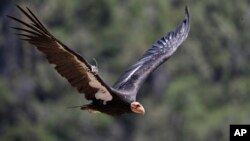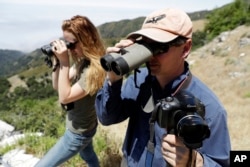In a remote, rugged valley overlooking the Pacific Ocean, researchers closely monitor an endangered icon: the California condor.
The giant vultures flap their wings and circle the sky before perching on branches and observing their observers.
Wildlife biologist Amy List uses a handheld antenna to track the birds, which wear radio transmitters and numbered tags.
"If we don't know what they're doing, we don't know what's going wrong,'' said List, who works for the Ventana Wildlife Society, which manages the condor sanctuary in Big Sur.
Three decades after being pushed to the brink of extinction, the California condor is making a comeback in the wild, but constant vigilance is needed to ensure the endangered bird doesn't reverse course.
One of the world's largest birds with a wingspan up to 10 feet, the condor once patrolled the sky from Mexico to British Columbia. But its population plummeted in the 20th century due to lead poisoning, hunting and habitat destruction.
In 1987, wildlife officials captured the last remaining 22 condors and took them to the San Diego and Los Angeles zoos to be protected and bred in captivity.
Those efforts have led to a slow but steady recovery for a species that reproduces slowly compared with other birds. There are now roughly 450 condors, including about 270 in the wild in California, Arizona, Utah and northeastern Mexico.
Plans also are underway to release some captive-bred condors in Redwood National Park in 2019 to establish a population near the California-Oregon border.
Federal officials said in August that for the first time in nearly 40 years, condors were roosting in the Blue Ridge National Wildlife Refuge, expanding to their historical range in the southern Sierra Nevada.
Another milestone was reached this summer: the first "third generation'' condor was born in the wild in California since the 1980s.
"We're seeing very encouraging results that the condors can become self-sustaining again,'' said Kelly Sorenson, who heads the conservation group.
While condors still face threats from exposure to mercury and the pesticide DDT, biologists say the biggest danger is lead ammunition, which can poison the scavengers when they eat dead animals shot with lead bullets. California banned the use of lead ammunition near condor feeding grounds in 2008 and will be the first state to ban lead bullets in all hunting in 2019.
"We're already starting to see fewer lead deaths. The condors are surviving longer. Their blood-lead levels are coming down,'' Sorenson said.
Some gun owners complain that copper bullets are more expensive and less effective than lead and point to other possible sources of lead, such as paint and metal garbage.
"Condors are getting lead poisoning. The question is, are they getting it from lead ammunition?'' said Chuck Michel, president of the California Pistol and Rifle Association.
Meanwhile, the San Diego Zoo celebrated the birth of its 200th condor this year.
"While we were caring for the birds, trying to protect them and provide sanctuary, we were literally writing the book how you propagate a species, how you genetically manage it and prepare it for release back in the wild,'' Michael Mace, the zoo's birds curator.
After up to a year at the zoo, chicks are taken to a release site such as the Big Sur sanctuary, where a flock has grown to about 90 condors that travel between Big Sur and Pinnacles National Park. They scavenge, breed and raise chicks on their own, under the close watch of List, the wildlife biologist, and her colleagues.
"I hope that I'm out of a job soon because condors don't need to be managed in the future,'' she said. "I hope that they're self-sustaining and wild and free, and nobody needs to trap or tag or monitor them at all.''







